Purine Pyrimidine Metabolism
Purine Pyrimidine Metabolism Overview
Purine Pyrimidine Metabolism
One of the important specialized pathways of a number of amino acids is the synthesis of purine and pyrimidine nucleotides. These nucleotides are important for a number of reasons. Most of them, not just ATP, are the sources of energy that drive most of our reactions. ATP is the most commonly used source but GTP is used in protein synthesis as well as a few other reactions. UTP is the source of energy for activating glucose and galactose.
CTP is an energy source in lipid metabolism. AMP is part of the structure of some of the coenzymes like NAD and Coenzyme A. And, of course, the nucleotides are part of nucleic acids. Neither the bases nor the nucleotides are required dietary components. (Another perspective on this.) We can both synthesize them de novo and salvage and reuse those we already have.
Nitrogen Bases
There are two kinds of nitrogen-containing bases - purines and pyrimidines. Purines consist of a six-membered and a five-membered nitrogen-containing ring, fused together. Pyridmidines have only a six-membered nitrogen-containing ring. There are 4 purines and 4 pyrimidines that are of concern to us.
Purines
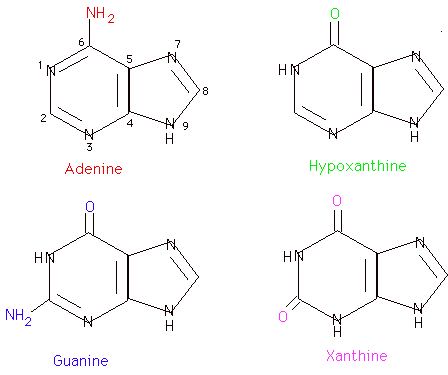
0. Adenine = 6-amino purine 0. Guanine = 2-amino-6-oxy purine 0. Hypoxanthine = 6-oxy purine 0. Xanthine = 2,6-dioxy purine Adenine and guanine are found in both DNA and RNA. Hypoxanthine and xanthine are not incorporated into the nucleic acids as they are being synthesized but are important intermediates in the synthesis and degradation of the purine nucleotides.
Pyrimidines
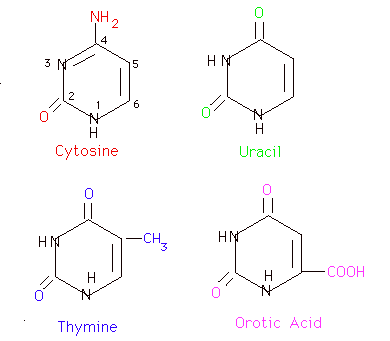
0. Uracil = 2,4-dioxy pyrimidine 0. Thymine = 2,4-dioxy-5-methyl pyrimidine 0. Cytosine = 2-oxy-4-amino pyrimidine 0. Orotic acid = 2,4-dioxy-6-carboxy pyrimidine
Cytosine is found in both DNA and RNA. Uracil is found only in RNA. Thymine is normally found in DNA. Sometimes tRNA will contain some thymine as well as uracil.
Purine Pyrimidine MetabolismNucleosides
If a sugar, either ribose or 2-deoxyribose, is added to a nitrogen base, the resulting compound is called a nucleoside. Carbon 1 of the sugar is attached to nitrogen 9 of a purine base or to nitrogen 1 of a pyrimidine base. The names of purine nucleosides end in -osine and the names of pyrimidine nucleosides end in -idine. The convention is to number the ring atoms of the base normally and to use l', etc. to distinguish the ring atoms of the sugar. Unless otherwise specified, the sugar is assumed to be ribose. To indicate that the sugar is 2'-deoxyribose, a d- is placed before the name.
0. Adenosine 0. Guanosine 0. Inosine - the base in inosine is hypoxanthine 0. Uridine 0. Thymidine 0. Cytidine
Purine Pyrimidine Metabolism
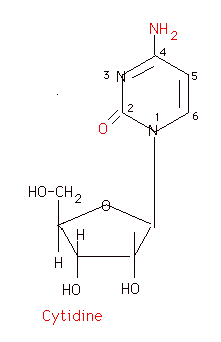
Nucleotides
Adding one or more phosphates to the sugar portion of a nucleoside results in a nucleotide. Generally, the phosphate is in ester linkage to carbon 5' of the sugar. If more than one phosphate is present, they are generally in acid anhydride linkages to each other. If such is the case, no position designation in the name is required. If the phosphate is in any other position, however, the position must be designated. For example, 3'-5' cAMP indicates that a phosphate is in ester linkage to both the 3' and 5' hydroxyl groups of an adenosine molecule and forms a cyclic structure. 2'-GMP would indicate that a phosphate is in ester linkage to the 2' hydroxyl group of a guanosine. Some representative names are:
0. AMP = adenosine monophosphate = adenylic acid 0. CDP = cytidine diphosphate 0. dGTP = deoxy guanosine triphosphate 0. dTTP = deoxy thymidine triphosphate (more commonly designated TTP) 0. cAMP = 3'-5' cyclic adenosine monophosphate
Purine Pyrimidine Metabolism
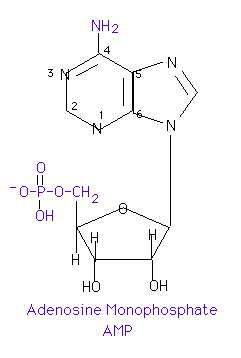
Polynucleotides
Nucleotides are joined together by 3'-5' phosphodiester bonds to form polynucleotides. Polymerization of ribonucleotides will produce an RNA while polymerization of deoxyribonucleotides leads to DNA.
Purine Pyrimidine Metabolism
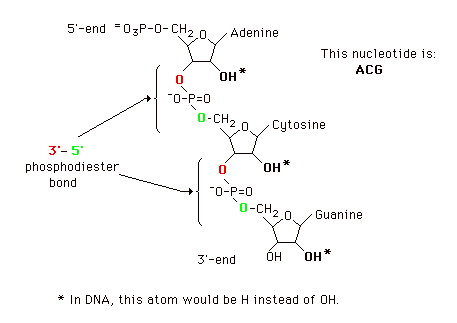
Hydrolysis of Polynucleotides
Most, but not all, nucleic acids in the cell are associated with protein. Dietary nucleoprotein is degraded by pancreatic enzymes and tissue nucleoprotein by lysosomal enzymes. After dissociation of the protein and nucleic acid, the protein is metabolized like any other protein. The nucleic acids are hydrolyzed randomly by nucleases to yield a mixture of polynucleotides. These are further cleaved by phosphodiesterases (exonucleases) to a mixture of the mononucleotides. The specificity of the pancreatic nucleotidases gives the 3'-nucleotides and that of the lysosomal nucleotidases gives the biologically important 5'-nucleotides. The nucleotides are hydrolyzed by nucleotidases to give the nucleosides and Pi. This is probably the end product in the intestine with the nucleosides being the primary form absorbed. In at least some tissues, the nucleosides undergo phosphorolysis with nucleoside phosphorylases to yield the base and ribose 1-P (or deoxyribose 1-P). Since R 1-P and R 5-P are in equilibrium, the sugar phosphate can either be reincorporated into nucleotides or metabolized via the Hexose Monophosphate Pathway. The purine and pyrimidine bases released are either degraded or salvaged for reincorporation into nucleotides. There is significant turnover of all kinds of RNA as well as the nucleotide pool. DNA doesn't turnover but portions of the molecule are excised as part of a repair process.
Purine Pyrimidine Metabolism
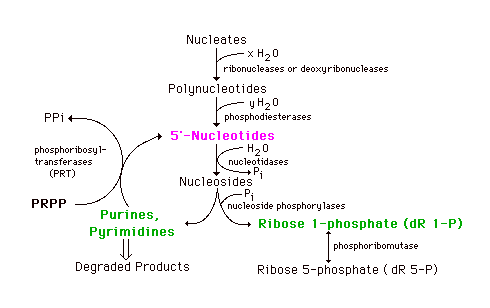
Purine and pyrimidines from tissue turnover which are not salvaged are catabolized and excreted. Little dietary purine is used and that which is absorbed is largely catabolized as well. Catabolism of purines and pyrimidines occurs in a less useful fashion than did the catabolism of amino acids in that we do not derive any significant amount of energy from the catabolism of purines and pyrimidines. Pyrimidine catabolism, however, does produce beta-alanine, and the end product of purine catabolism, which is uric acid in man, may serve as a scavenger of reactive oxygen species.
Purine Pyrimidine Metabolism
Reprint Permission Given to Gout-Aware All Articles written & supplied by
Dr Carol .N. Angsatdt Ph.D Department of Biomedical Sciences Allegheny University of Health Sciences
Reprint Permission Given to Gout-Aware All Articles written & supplied by
Dr Carol .N. Angsatdt Ph.D Department of Bimedical Sceinces Allegheny University of Health sciences
Purine Pyrimidine Metabolism
Recent Articles
-
Tony
May 08, 24 08:57 PM
Hi Peter, I am a physician, had my first Gout episode last week. I was surfing through the web and happened to come across your site. I am impressed by -
What is it about Cherries?
Aug 25, 21 03:59 AM
Allopurinol worked for me, but at the expense of adversely affecting my mood.I like cherries, but getting them every day of the year is a problem.I wondered -
ACV made my gout worse...
Apr 22, 20 07:19 AM
During my first gout attack, I was in so much pain that I desperately scoured the internet for alternative cures as the colchicine that I was prescribed







